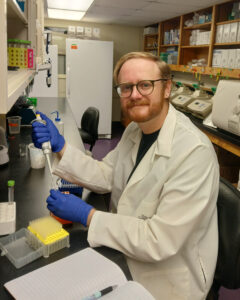ESEB and the Journal of Evolutionary Biology (JEB) award an annual prize for the best graduate papers published in the journal in that calendar year. The award is named after Stephen Stearns, who played a major role in establishing both JEB and ESEB (article).
The Stearns Graduate Student Prize is aimed at recognising outstanding graduate (Masters or PhD) research. While previously awarded to a single winner, since 2022 the JEB editorial board selects up to three joint awardees each year. This change recognises the fact that research excellence comes in many facets, ranging from the innovative nature of the questions addressed, over the technical challenges in performing the research to the scientific and societal impact of the results.
The award includes an invitation to attend the ESEB Congress (registration fee covered), where awardees present their work in a dedicated Stearns Prize symposium.
Information
Eligibility
The Stearns Prize recognises the outstanding contribution of graduate students to research published in JEB. Graduate students are eligible for the prize if they led both the research described in the article and the writing of the manuscript itself (supervisors will be asked to confirm this before awards are made). Reflecting their role, we would then also usually expect the student to be the lead (first) author. We expect papers to be submitted within two years of completing the project.
Nomination
Student-led articles that are eligible for the Stearns Prize are identified at the point of submission through a question “Was this study led by a graduate student?” in the ScholarOne form. Any manuscript for which the corresponding author answers “Yes” and identifies the student among the authors will, if accepted, be automatically considered for the Stearns Prize in the year of its publication. Self-nomination is encouraged, where the graduate student leading the study is also the submitting and corresponding author.
Selection criteria
All papers published in JEB that were entered at the point of submission as above are considered for the Stearns Prize. Editors will be asked to shortlist articles from the student-led papers they handled based on the following criteria:
- addresses an innovative research question or approaches the question in an innovative way
- contains technically challenging work
- displays a particularly robust approach to answering the research question
- demonstrates commitment to Open Science through the quality of the archived material accompanying the article (e.g. detail of readme files, organisation, presence of code) that maximises the potential for reusability and reproducibility of the research.
Shortlisted papers are then ranked using the same criteria as above by a panel of editorial board members, who have no conflicts of interest and who did not handle the papers, to minimise bias towards a particular field. The panel will be instructed to be aware of potential biases in their evaluation i.e. gender, nationality, geographic location. The top papers will be awarded the Stearns Prize for that calendar year.
2024 Winners
Théo Bodineau

This research paper was driven by the need to better understand relative contributions of breeding dates and thermal conditions during gestation on fitness of females and their offspring in viviparous reptiles. I am honoured to receive a Stearns Prize for this research which was conducted as part of my PhD at the Institute of Ecology and Environmental Sciences of Paris, Sorbonne University (France), in collaboration with my PhD advisors Sandrine Meylan, Pierre de Villemereuil, Jean-François Le Galliard and field engineers from the CEREEP-Ecotron IleDeFrance (France), Beatriz Decencière and Simon Agostini. We exposed females of the common lizard (Zootoca vivipara) to contrasting thermal scenarios (cold vs. hot treatment) during gestation and quantified effects of parturition dates and thermal treatment on life-history traits of females and their offspring for one year. Overall, our results suggest that parturition date has a greater impact than thermal conditions during gestation on life-history traits of females and juveniles. Moreover, our findings reveal a potential mother-offspring conflict regarding the optimisation of parturition dates: while earlier parturition enhances juvenile survival, growth, and recruitment, it simultaneously imposes energetic costs on pregnant females. Although numerous studies focused on the direct effects of alterations in incubation temperatures on reptile life-history traits, our results highlight the importance of considering the role of breeding phenology in assessing the short- and long-term effects of thermal developmental plasticity.
Marion Leménager

I am deeply honored to receive the Stearns Prize in recognition of my research on the intraspecific evolution of floral variation within pollination systems involving both specialists and generalists. This work was carried out during my PhD at the Institut de Recherche en Biologie Végétale, University of Montreal, and Montreal Botanical Garden, under the mentorship of Simon Joly.
The study was driven by a desire to better understand how variation within species shapes broader evolutionary patterns. Centered on the niche variation hypothesis, we explored how the broader ecological niches of generalist species may lead to greater morphological diversity—either through the presence of diverse specialists within a species or through relaxed selective pressures on true generalist individuals.
Focusing on Antillean Gesneriaceae—a tropical plant group that has repeatedly transitioned between pollination by hummingbirds and generalist systems—we examined how floral shape, particularly corolla tubularity and curvature, varies within species. Using geometric morphometrics, ancestral reconstructions, and methods that differently accounted for the high dimensionality of morphological traits, the ancestral reconstruction of pollination syndromes over time, and the error associated with the estimation of the intraspecific variance, we evaluated patterns of intraspecific variation.
Our findings partially support the niche variation hypothesis. While generalists showed more variation overall, especially in tubularity, not all aspects of floral shape followed this trend. Moreover, accounting for sampling error highlighted the importance of robust datasets in evolutionary studies.
This research underscores the dynamic interplay between ecological strategies and morphological evolution and highlights how pollinator interactions can influence biodiversity patterns across scales.
Quinn McCallum

I’m honoured to accept the Stearns Graduate Student Prize for this research, which I conducted at UBC as part of my Honour’s thesis under Dr. Darren Irwin. Our goal with this study was to characterize patterns of genomic differentiation between Zonotrichia atricapilla (the Golden-crowned Sparrow) and Zonotrichia leucophrys (the White-crowned Sparrow) using Genotyping-by-Sequencing (GBS). Previous work had found that these species share mitochondrial haplotypes despite marked differences in phenotype and allozyme sequences, a pattern attributed to mitochondrial introgression. Contrastingly, we uncovered extremely high relative differentiation and increased absolute differentiation across a large region of the Z‑chromosome, suggesting a region that has resisted introgression between these species. Furthermore, patterns of linkage disequilibrium in this region were consistent with reduced recombination between the two species, but not within each species, a pattern that may be the result of a chromosomal inversion. Additionally, we found evidence of admixture between two previously allopatric subspecies of Z. leucophrys. Broadly, I’m interested in how ecological traits and geographical features influence diversification, the genomic architecture of local adaptation and reproductive isolation, and introgression as source of adaptive genetic variation. For my PhD, I’ve moved to Louisiana State University, where I’m advised by Dr. Nicholas Mason. My current research uses comparative phylogeography to study how ecological and life history traits affect population structure and gene flow in high Andean birds.
Kane Stratman

It was an honor to receive the Stearns Prize for my recent study, which concluded my PhD research on the dynamics of sexual selection on the well-known high-energy mating call of male Eastern Gray Treefrogs (Hyla versicolor). My advisor Gerlinde Hoebel and I aimed to quantify the disparity between a) what male advertisers are capable of displaying and b) what female choosers seek in an ideal mate. We focused not on population-level estimates of preference, but rather on patterns of within-population level preferences, which may capture conflicting but biologically meaningful mate choice dynamics. Our study revealed that, across three separate elements of a male treefrog’s mating signal, at most 62% of individual females exhibit preferences consistent with the population average. In the case of a male’s calling rate, we discovered a nearly dichotomous female response to high intensity call values, greatly complicating any model of male mating strategy in this system. Population estimates of sexual selection on any given advertisement trait may, as we demonstrate, accurately model the direction of selection, whilst missing entirely the primary basis for mating decisions in the wild. Hidden variation in mating preferences among-choosers may explain why lower resolution measures of preference shapes significantly underestimate variation in male fitness.
Previous Winners
2023
Matthew C. Farnitano
“Strong postmating reproductive isolation in Mimulus section Eunanus” (https://doi.org/10.1111/jeb.14219)
Jason R. Laurich
“Genetic architecture of multiple mutualisms and mating system in Turnera ulmifolia” (https://doi.org/10.1111/jeb.14098)
Tian Xia
“Reproductive isolation via divergent genital morphology due to cascade reinforcement in Ohomopterus ground beetles” (https://doi.org/10.1111/jeb.14116)
2022
Haley Kenyon
“Experimental test of selection against hybridization as a driver of avian signal divergence” (https://doi.org/10.1111/jeb.14058)
Subham Mridha
“Enforced specialization fosters mutual cheating and not division of labour in the bacterium Pseudomonas aeruginosa” (https://doi.org/10.1111/jeb.14001)
Donal Smith
“Challenging a host–pathogen paradigm: Susceptibility to chytridiomycosis is decoupled from genetic erosion” (https://doi.org/10.1111/jeb.13987)
2021
Juliette Aminian Biquet
“Phenotypic plasticity drives phenological changes in a Mediterranean blue tit population” (https://doi.org/10.1111/jeb.13950)
2020
Jack Common
“Diversity in CRISPR-based immunity protects susceptible genotypes by restricting phage spread and evolution” (https://doi.org/10.1111/jeb.13638)
2020 – Runners-up were Bruno Genevcius, Graeme Keais, and Alexandra Cones.
2019
Thomas Keaney
“Mother’s curse and indirect genetic effects: do males matter to mitochondrial genome evolution?” (https://doi.org/10.1111/jeb.13561)
2019 – Runners-up were Nadia S. Sloan and Daniel Shane Wright.
2018
James Santangelo
“Herbivores and plant defenses affect selection on plant reproductive traits more strongly than pollinators” (https://doi.org/10.1111/jeb.13392).
2018 – Runners-up were Eva Troianou, Peter Moran, Urtzi Enriquez-Urzelai, Joshua Alpern, and Casper van der Kooi.
2017
Jack Colicchio
“Transgenerational Effects Alter Plant Defense and Resistance in Nature” (https://doi.org/10.1111/jeb.13042)
2017 – Runners-up were Keely Brown, Zacharia Grochau-Wright, Ryosuke Iritani, Kim Kirchhoff , and Erin Morrison.
2016
Amaranta Fontcuberta
“Extreme genetic diversity in asexual grass thrips populations” (https://doi.org/10.1111/jeb.12843)
2016 – Runners-up were Matt Wilkins and Karl Grieshop.
2015
James Lichtenstein
“Similar patterns of frequency-dependent selection on animal personalities emerge in three species of social spiders” (https://doi.org/10.1111/jeb.12651)
2015 – Runners-up were Arthur Porto, Evan Hersh, and Damien Farine.
2014
Ellie Harrison
“Sex drives intracellular conflict in yeast” (https://doi.org/10.1111/jeb.12408).
